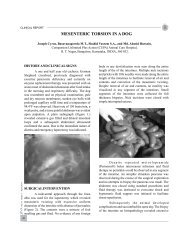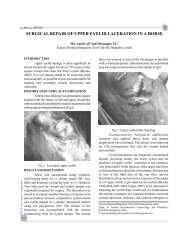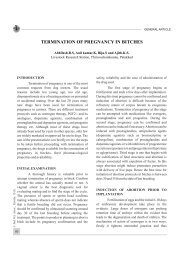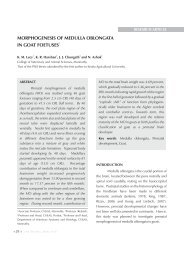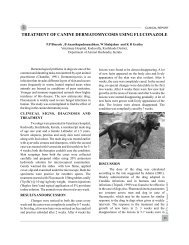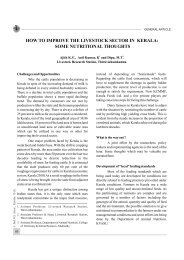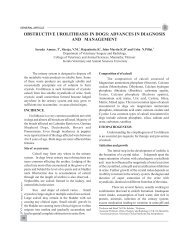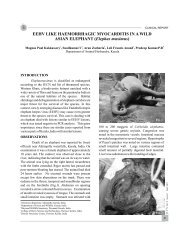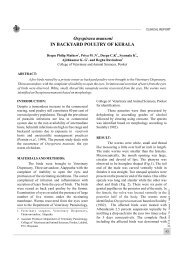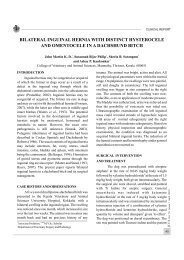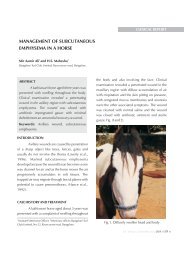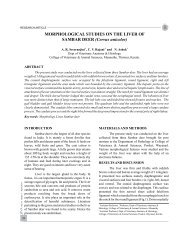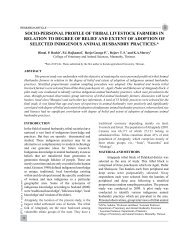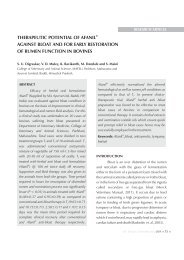2012 Jiva April Cover 220 GSM Art Card Glossy ... - Jivaonline.net
2012 Jiva April Cover 220 GSM Art Card Glossy ... - Jivaonline.net
2012 Jiva April Cover 220 GSM Art Card Glossy ... - Jivaonline.net
You also want an ePaper? Increase the reach of your titles
YUMPU automatically turns print PDFs into web optimized ePapers that Google loves.
and lower stratosphere leading to depletion of ozonelayer. Indirectly it reacts with carbon dioxide a greenhouse gas. The reaction is complex as 1) methane hasabsorption band in the infrared region 2) It isoxidized in troposphere by free hydroxyl radical 3) Itis sizeable source of carbon monoxide throughoxidation. 4) Stratospheric methane can react withchlorine from hydrochloric acid which destroysozone layer.METHANOGENESIS IN RUMINANTSMethane is produced in rumen strictly underanaerobic condition and serves as a hydrogen sink.Most of the methane is produced in rumen by thereduction of carbon dioxide and some is derived fromformate. Methanogenic bacteria are mainlyresponsible for methane production, which involvesa specialized biochemical function.Methanogenesis is a very intricate processthat involves vitamin B 12, folic acid, coenzyme (2Mercapto ethane sulfonic acid), fatty acid and methylbutyrate. Half of the hydrogen produced duringfermentation of carbohydrate is used for propionateproduction , biohydrogenation of unsaturated fattyacid and the other half for methane productionThe fermentation reaction are given below1. C6H 12O6 2CH3COOH + 2CO2+ 8(H)(Acetate) (Methanogenic)2. C6H12O6 2CH3CH 2COOH + 2H2O + 4(H)(Propionate) (Glucogenic)3. C6H 12O6 CH3CH2-CH-COOH + 2CO2+ 4(H)(Butyrate) (Methanogenic)Of the sixteen hydrogen molecules producedduring the fermentation of carbohydrate, eighthydrogen molecules are utilized for propionateformation and other eight is converted to methane asshown.4H + COCH + 2H O2 2 4 2Ruminants produce about 20g of methane foreach kg of dry matter intake. Methane production incattle is affected by variety of nutritional factorsincluding level of intake, type of carbohydrate,forage processing, and change in the rumenmicroflora. Diet favoring propionate production inrumen causes decrease in methane and diet likeroughage favours acetate production, whichincreases methane production. The molar proportionof volatile fatty acid plays a key role because fibrousfeed results in higher methanogenic VFA (Prestonand Leng 1987). So narrowing of the acetate:propionate ratio would increase performance inruminants.Table.2. Methanogenic bacteria and their substrates for methane productionBacteria Substrates ProductsMethanobacterium ruminantium CO , H and HCOOH CH , CO and H O2 2 4 2 2Methanobacterium formicicum HCOOH CH , CO and H O4 2 2Methanobrevibacter ruminantium HCOOH CH , CO and H O4 2 2Methanobacterium mobile HCOOH CH , CO and H O4 2 2Methanosarcina barkerii Methanol, Acetate CH , CO and NH4 2 4METHANE MITIGATION -A BOON TOFARMERS AND ENVIRONMENTIt is desirable to maximally utilize fibre forruminant production, because plant fibre is the mostabundant organic matter that is available, and thegreatest merit of ruminants is the ability to utilizeGENERAL ARTICLEfibre. As the current practice of feeding highconcentratediets to cattle is a luxury that futuregenerations may not experience. An improvement infibre utilization will become increasingly important.Therefore, it is critical to develop strategies aimed atreducing ruminal methanogenesis withoutJIVA Vol. 10 Issue 1 <strong>April</strong> <strong>2012</strong>57



